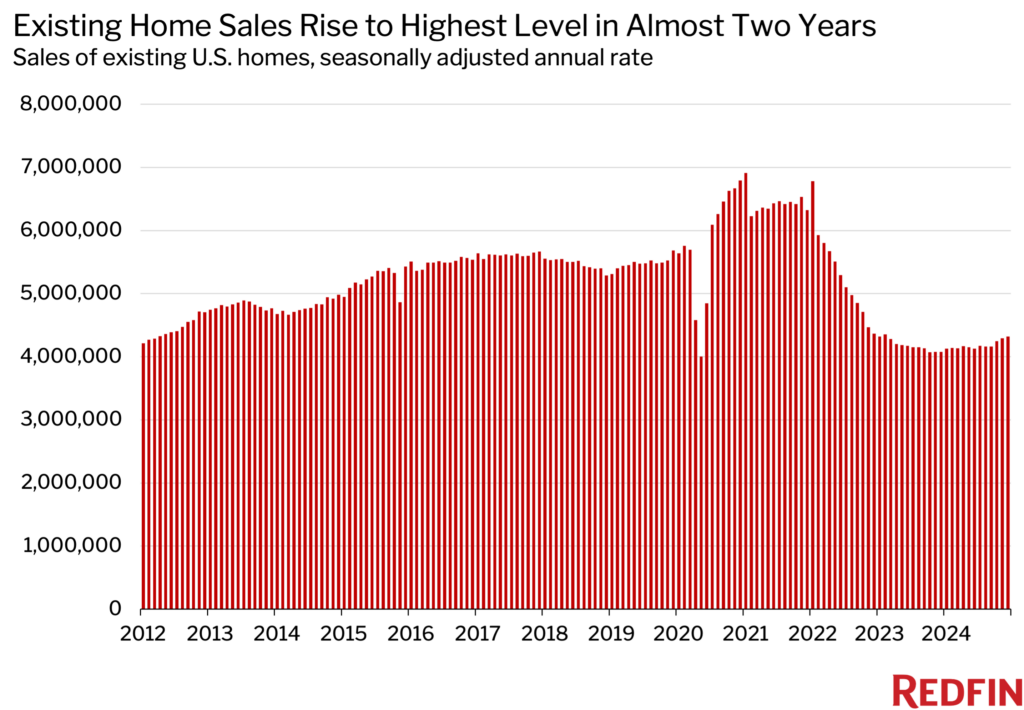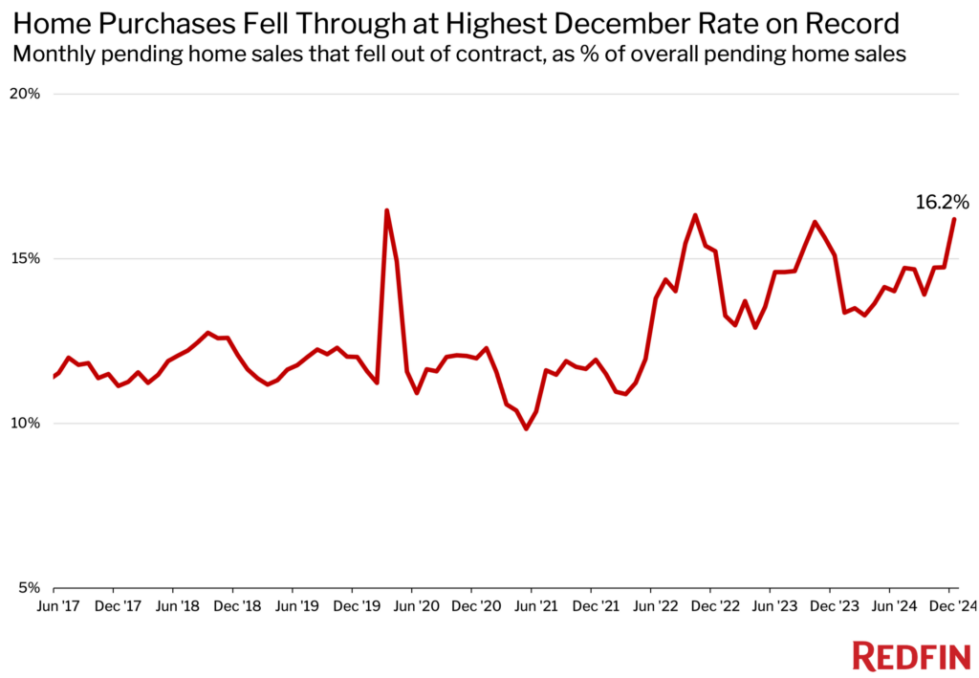- Pending home sales dropped 4.5% from November as mortgage rates jumped to the highest level in months.
- Roughly 40,000 home purchases were called off in December, equal to 16% of homes that went under contract—the highest December percentage on record.
- Existing home sales—a lagging indicator of deals that were negotiated in prior months when mortgage rates were lower—rose to the highest level in nearly two years.
Pending home sales fell 4.5% month over month in December on a seasonally adjusted basis, the largest decline since October 2022. They dropped 2.3% year over year.
Homebuyer demand dipped at the end of the year because mortgage rates jumped. After inching downward at the beginning of the month, mortgage rates reversed course halfway through December and have been rising since—in part because the Federal Reserve projected fewer 2025 interest-rate cuts than anticipated. The weekly average 30-year-fixed mortgage rate now sits at 7.04%, the highest level since May, after hitting an early-December low of 6.6%.
Home purchases fell through at the highest December rate on record, which likely contributed to the decline in pending sales. Nearly 40,000 home-purchase agreements were canceled in December, equal to 16.2% of homes that went under contract that month. That’s the highest December percentage in records dating back to 2017 and is up from 15.1% a year earlier.
Please note that homes that fell out of contract during a given month didn’t necessarily go under contract the same month. For example, a home that fell out of contract in December could have gone under contract in November.
“Homebuying activity will likely slow further in January due to the wildfires impacting Los Angeles—the nation’s second most populous metro area—and winter storms impacting the Mid-Atlantic and Southeast,” said Redfin Senior Economist Elijah de la Campa. “Rent prices, on the other hand, may tick up as people who have been displaced by the fires seek alternative housing.”
Existing Home Sales Rose to the Highest Level in Nearly Two Years
Existing home sales rose 0.7% month over month in December to a seasonally adjusted annual rate of 4,317,683—the highest level since February 2023. They jumped 6% year over year—the largest annual increase since July 2021.

A seasonally adjusted annual rate is not a measurement of actual total sales for the year, but rather, the pace of sales at a given time. A seasonally adjusted annual rate of 4,317,683 in December means that existing home sales would end the year at that level if homes were sold at the December pace for each month of 2024. For the full year of 2024, actual existing home sales came in at 4,189,268—roughly in line with 2023.
Overall home sales, a metric that includes sales of both existing and newly built homes, rose 1.9% month over month on a seasonally adjusted basis. They jumped 9.3% year over year, the biggest annual gain since June 2021.
It’s worth noting that both existing and overall home sales are lagging indicators. They reflect purchases that, while finalized in December, went under contract (AKA pending) during the several months leading up to December. Those several months were a key time in the housing market; housing demand jumped in September as mortgage rates hit a two-year low and the Federal Reserve cut interest rates, and then jumped again after the uncertainty around the election disappeared.
“Homebuyers pumped the brakes when mortgage rates ticked back up, and are now in wait-and-see mode,” said Jesse Landin, a Redfin Premier real estate agent in San Antonio. “Everyone is just trying to figure out when rates are going to come down again. In the meantime, a lot of house hunters are opting to rent.”
Redfin expects mortgage rates to remain elevated and volatile throughout 2025.
December 2024 Housing Market Highlights: United States
| December 2024 | Month-over-month change | Year-over-year change | |
|---|---|---|---|
| Median sale price | $427,670 | -0.5% | 6.3% |
| Existing home sales, seasonally adjusted annual rate | 4,317,683 | 0.7% | 6.0% |
| Pending home sales, seasonally adjusted | 471,888 | -4.5% | -2.3% |
| Homes sold, seasonally adjusted | 449,684 | 1.9% | 9.3% |
| New listings, seasonally adjusted | 515,054 | -1.6% | -1.5% |
| Total homes for sale, seasonally adjusted (active listings) | 1,723,121 | -0.3% | 7.0% |
| Months of supply | 2.5 | -0.6 | -0.1 |
| Median days on market | 49 | 6 | 6 |
| Share of homes sold above final list price | 24.2% | -2.4 ppts | -1.4 ppts |
| Average sale-to-final-list-price ratio | 98.5% | -0.3 ppts | -0.1 ppts |
|
Pending sales that fell out of contract, as % of overall pending sales |
16.2% | 1.5 ppts | 1.1 ppts |
| Monthly average 30-year fixed mortgage rate | 6.72% | -0.09 ppts |
-0.1 ppts |
Note: Data is subject to revision
Home Prices Posted the Largest Gain in Almost a Year
The median U.S. home sale price increased 6.3% year over year to $427,670 in December, the biggest annual gain since February.
Prices continue climbing because there’s still a shortage of homes for sale. New listings fell 1.6% month over month on a seasonally adjusted basis and declined 1.5% year over year.
Active listings, a measure of all homes on the market, fell 0.3% month over month—the first decline on a seasonally adjusted basis in five months. They rose 7% year over year, but that was the smallest annual increase in nearly a year. One reason active listings are rising is that some homes are taking a long time to sell, causing stale supply to pile up.
Homes Sold at the Slowest December Pace in Five Years
The typical home that went under contract in December was on the market for 49 days—the slowest December pace since 2019. That’s up from 43 days a year earlier.
Just 25.1% of homes went under contract within two weeks—the lowest share in five years. That’s down from 28.4% in December 2023.
One silver lining in a slow housing market: Buyers have more flexibility to bide their time and ask sellers for concessions.
Metro-Level Highlights: December 2024
The bullets below are based on a list of the 50 most populous U.S. metropolitan areas. Some metros may be removed from time to time to ensure data accuracy. A full metro-level data table can be found in the “download” tab of the dashboard in the monthly section of the Redfin Data Center. Refer to our metrics definition page for explanations of metrics used in this report. Metro-level data is not seasonally adjusted. All changes below represent year-over-year changes.
- Prices: Median sale prices rose most from a year earlier in Cleveland (15%), Milwaukee (14.5%) and Philadelphia (14%). They rose least in three Florida metros: Tampa (0.5%), Orlando (1.3%) and Jacksonville (1.3%).
- Pending sales: Pending sales rose most in Anaheim, CA (9.7%), Phoenix (9.4%) and New Brunswick, NJ (6.9%). They fell most in Newark, NJ (-12.5%), New York (-9.3%) and Orlando (-9.1%).
- Closed home sales: Home sales rose most in San Diego (28.4%), San Jose, CA (25.8%) and Anaheim (24%). They fell in three metros: West Palm Beach, FL (-9.8%), Fort Lauderdale, FL (-3.5%) and Detroit (-1.3%).
- New listings: New listings rose most in San Francisco (26.8%), Oakland, CA (21.1%) and Anaheim (16%). They fell most in San Antonio (-16.8%), Newark (-10.6%) and Austin, TX (-10.2%).
- Active listings: Active listings rose most in Cincinnati (37.3%), Fort Lauderdale (33%) and San Diego (26.3%). They fell most in Newark (-9.5%), San Francisco (-5.1%) and San Antonio (-3.3%).
- Sold above list price: In Newark, 60.5% of homes sold above their final list price, the highest share among the metros Redfin analyzed. Next came San Jose (52.1%) and Nassau County, NY (50.9%). The lowest shares were in West Palm Beach (6%), Miami (6.9%) and Fort Lauderdale (9%).
Written by: Lily Katz

